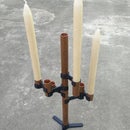Introduction: Compact Flat Packed Ironer
Hi
I am a student Industrial product design at Howest. We got the assignment to make a flat pack product (furniture, illumination or grid design weren't allowed). So I started brainstorming, and came out with the idea to make a flat pack iron.
You can follow these steps to make your own working flat pack iron!
Step 1: Getting the Needed Materials
What do you need!
Materials:
- A sole plate of a steamless iron, I got it from an old iron, but you can go with newer ones to make the product more flat (make sure you keep the thermostat).
- Some knowledge in electricals
- Sheet alluminum, thickness 2mm
- Sheet of silicone rubber (you can get it from a cake bake form).
- Mdf, thickness 3mm (the mdf in the photo is alreay lasercutted)
- Bolts
- Silicone tubings
Tools and devices:
- Laser cutter (you can do it by hand but it will be more difficult).
- Pillar drill
- Jigsaw
- Screwdrivers
- Wood glue
- Files
- Soldering iron
Step 2: Electronics
Make sure all the electronic elements are in place and work. The only thing I'm going to use is a thermostat and the resistance wire (you can use the button on the thermostat to change the temp on your iron, but I left it away).
So first off, you put the silicone tubings on the risistance wire. Then you connect 1 end of the wire with the thermostat (you can use a soldering iron for that). When the iron is finished you can attach the plug to the iron.
It's not that hard to do, but be carefull! There is 220 Volt on an iron so make sure you isolate al the parts from your sole plate.
Step 3: Cutting and Fitting the Silicone Rubber
Now you need to cut the silicone rubber sheet, so it will fit the form of the sole plate.
Make sure you have some backlash.
Keep an eye on the holes in the sole plate, you will need them to secure the aluminium housing.
You just need to make sure that there is no contact from the soleplate to the aluminum housing, otherwise you can burn yourself very badly.
Step 4: Making the Handle
This requires some knowledge with lasercutters.
You can see my Illustrator file that I sent to the lasercutter. Now you alse need to make something like that, but your messurements are probably different as mine, because you have another soleplate. The handle needs to be U shaped so it can slide on the iron and be very compact in order to fit, for example, in a drawer or for shipment.
When you lasercuted your 3mm mdf plate, you need to put the handle together. I used strong wood glue, put it on and between the teething and pressed it together. Do this for all parts, until you have the U shaped handle.
Be carefull! Don't be to quick and give the glue the time to dry.
Step 5: Cutting the Aluminum
Our following step is not that hard but you need to focus. You must make the housing so, that if you put the iron on his side, the sole plate doens't touch the ground!
I made the needed form first in cardboard, that will make it easier to edit the alluminium later on. I drew the form on the alluminium plate and cutted it out with a metal jigsaw. It might be useful to cut the form slightly bigger to correct mistakes later on.
Now, if you have the outer shape, you need some holes and a slot.
pic3: Here you can see the hole I made where the handle fits trough and then slides forward.
pic4: The slot you need to make must be on the backside right under the fold, so you can slide a plate in that will seccure the handle.
Step 6: Folding the Aluminum
The hard part!
This is not easy! Make sure you test it before on cardboard so you are certain in what order you have to fold the parts.
I'm going to explain how you make a fold:
- Grab a box cutter and a ruler and cut on the outside of the way you wanna fold.
- Cut trough 1/3 of the material.
- Put the line of the fold between 2 wooden boards.
- Take a third board and put it on the part you want to fold.
- Press hard on the rhid board and fold it in to a right angle.
After many tryouts, I made it to the right form!
Now you can file of the uneven pieces to make it nice and smooth.
Step 7: Drilling the Holes
I have 4 threaded holes in my sole plate. Therefore, I need to drill 4 wholes in my housing, messure the wholes and drill them through my aluminium plate. Make sure they fit exactly on the soleplate, so everything fits nicely in the end.
Make sure you attach the plug to the wires before you close it.
Step 8: Adjusting the Handle
You need to grind a gap in the handle so it slides on the housing.
I had to cut a small piece out of the bottom because I have a fold there.
Step 9: Making the Lock System
You cutted out the slot before, now you need to make a U shaped sheet metal part that slides in the slot and holds the handle in place.
If you have done that, file it so you get a perfect strong lock, then drill 2 holes in it. Make sure they are alined with the holes before.
You can screw everything together, and you are done!
Step 10: Varnishing!
You can leave it like this, but I varnished it.
You can choose wich parts you varnisch and which parts not.
Before you start varnishing, make everything smooth and clean.
The metal dries relatively quickly, but the wood needs a lot off layers and a long time to dry. Be patient :)
MAKE SURE THE VARNISCH IS HEAT RESISTANT (!!) for stoves etc
Step 11: How Does It Work
So you can slide the handle in the hole you cut for it.
Then you take your lock system and put it in the slot. Take your bolts and screw them through you housing and through the lock system in the sole plate. Your handle should be locked in place. You can do the same for unlocking the iron and making it compact.
Step 12: Slide the Handle on and DONE!
So this was it!
Check your electrics to be sure, plug it in and enjoy ironing!
This is made for short ironing, don't use it to long or you will get burned. You can put it easy away in your drawer or in your suitcase.











